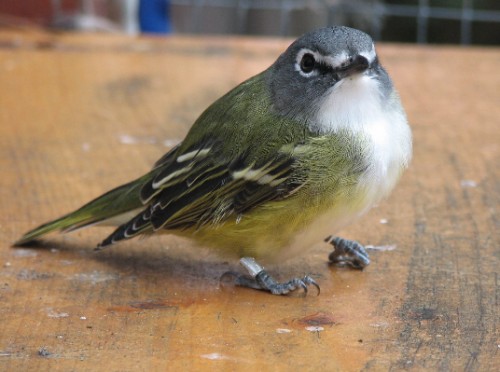|
Week 11: October 10-16, 2006 |
Welcome
to the McGill Bird Observatory weekly report.
Click here for a complete listing of our archives.
Comments or
questions are welcome at "mbo AT migrationresearch.org".
|
PICTURE
OF THE WEEK: |
|

Here’s lookin’ at you, kid… Or at least that what we think
this pale American
Robin
was
saying as it posed for us Monday morning. While it wasn’t
leucistic
or albino, this bird is definitely different! (Photo
by Gay Gruner)
|
 |
MBO
gratefully acknowledges the financial support
provided for the 2006 Fall Migration Monitoring
Program by Mountain Equipment Co-op's
Environment Fund |
|
|
|
THIS WEEK |
THIS FALL |
2006 TOTAL |
SITE TOTAL |
|
# birds (and species) banded |
241 (22) |
2853 (74) |
3788 (83) |
8841 (96) |
|
# birds (and species) repeat |
49 (10) |
372 (36) |
609 (39) |
1487 (52) |
|
# birds (and species) return |
2 (1) |
26
(9) |
123 (22) |
192 (26) |
|
# species observed |
61 |
134 |
159 |
180 |
|
# net hours |
310.3 |
3897.6 |
7009.4 |
13431.5 |
|
# birds banded / 100 net hours |
77.7 |
73.2 |
54.0 |
65.8 |
|
|
Note: table does not include nocturnal banding (owls) |
Bander-in-charge:
Marie-Anne Hudson, Barbara Frei
Assistants:
Jean Beaudrault,
Dan Brown, Veronik Campbell, Sophie Cauchon, Natalia
Castelanos, Alejandro Del Peral, Jean Demers, Emilie Dion, David
Fishman, Marcel Gahbauer, Gay Gruner, Kanako Hasegawa, Amy Henderson,
Sabrina Lalande, Barbara MacDuff, Laurie Maurais, Betsy McFarlane, Chris Murphy,
Gillian Murphy, Ian Niu, Annie-Claude Paradis, André Pelletier, Limoilou
Renaud, Clémence Soulard, Rachel Verkade
Notes:
This week was noticeably slower than the last few, allowing us the
opportunity to tinker with our net set-up
and the ever-present J-trap.
The product: an operational J-trap, and two nets that have been largely
unused this fall due to their distance from the banding season have been
moved closer, adding an additional net to each of A and E. So far the
nets
appear to be working quite nicely,
but the J-trap has yet to catch anything. It’ll likely be a while
before the birds realize that we’ve laid out a bounty of food for them,
but that's alright. We're a patient bunch.
If one species were to characterize the week, it would certainly be the
American Robin. They arrived ‘en masse’ at the beginning of the week,
with a peak of roughly 1500 on Sunday. They
have been concentrating in the tall cottonwoods lining B (unfortunately
- or fortunately - closed due to excessive leaf-fall along there), but
have also been steadily streaming south high above the site. It’s
quite spectacular to hear them begin squawking away as the sun rises,
only to fall silent as a Cooper’s Hawk or Merlin flies by.
|

A side
view of this week's unusually pale American Robin (Photo by Gay
Gruner) |
This week’s newly-banded species include Hairy Woodpecker (a long time
coming) and House Sparrow. It seems that these little guys disappear
for a while after the breeding season, only to come back in time for our
winter feeder nets. Newly sighted species for the season include
American Tree Sparrow -- a sure sign that winter is on its way -- Pine
Siskin and Cackling Goose.
This
week's top 10 [last week's rank in
brackets]
|
# individuals banded |
mean # individuals
observed daily |
|
American Robin (82) [4] |
American Robin (419) [2] |
|
Ruby-crowned Kinglet (71) [1] |
Canada Goose (233) [1] |
|
Golden-crowned Kinglet (15)
[8] |
Red-winged Blackbird (132)
[4] |
|
Hermit Thrush (14) [7] |
American Crow (131) [3] |
|
White-throated Sparrow (13)
[3] |
Ruby-crowned Kinglet (41)
[5] |
|
Yellow-rumped Warbler (6)
[2] |
Cedar Waxwing (31) [-] |
|
Song Sparrow (6) [6] |
Mallard (27) [-] |
|
Blue Jay (5) [-] |
European Starling (27) [-] |
|
Slate-colored Junco (5)
[-] |
White-throated Sparrow (21)
[6] |
|
White-crowned Sparrow (4)
[5], Orange-crowned Warbler (4)
[-] |
Blue Jay (20) [8] |
|
This week’s banding top ten is dominated by two species: American Robin
and Ruby-crowned Kinglet,
which is no surprise to anyone who’s been on-site over the past few
days. The robin peak is right on schedule, as the largest flocks passed
between October 14 and 19 last year as well. The top ten sighted
species are relatively similar to those of last week, with the exception
of Cedar Waxwing, European Starling and
Mallard making an appearance. It’s anyone’s guess as to who will occupy
the same spots next week, though we anticipate a big push of Slate-coloured
Juncos to arrive soon, along with increasing numbers of American Tree
and Fox Sparrows.
|

It’s rare to get such a clear shot of a vireo, but this little
guy posed quite nicely for us while deciding where to fly after
being released. Notice the band?
(Photo by Barbara Frei)
|




